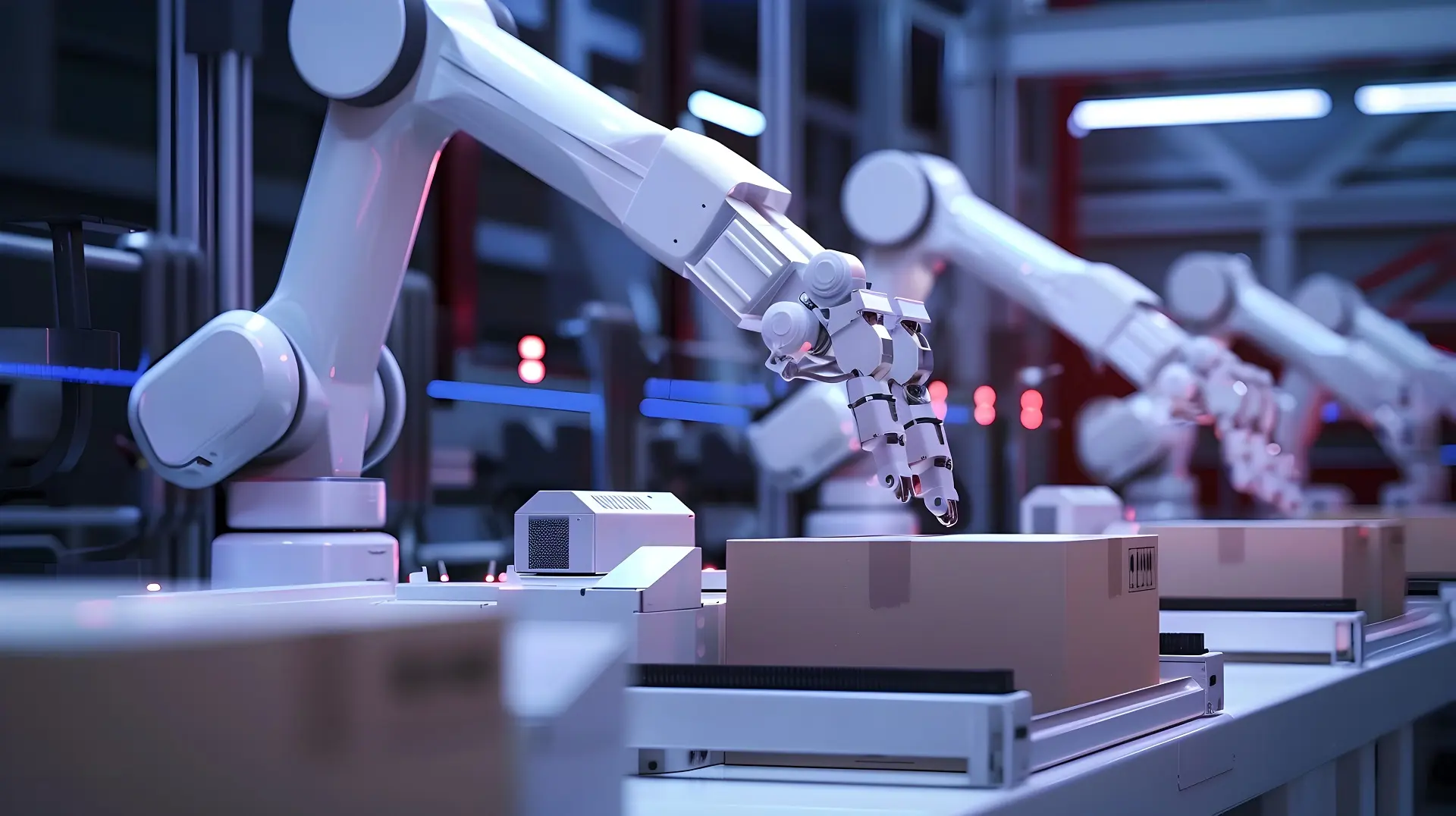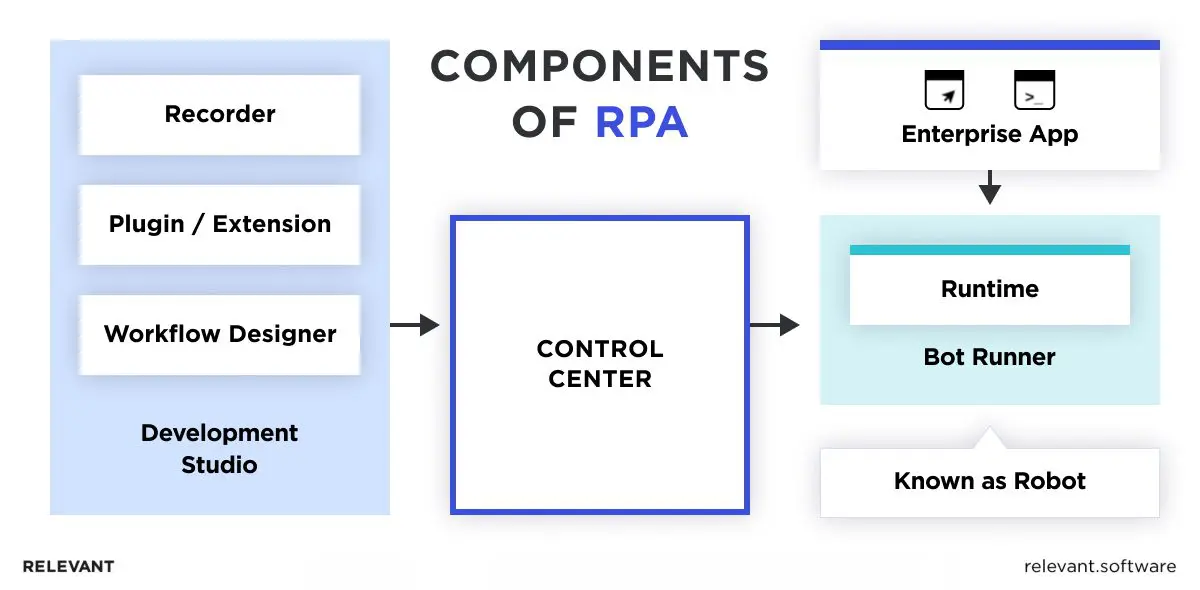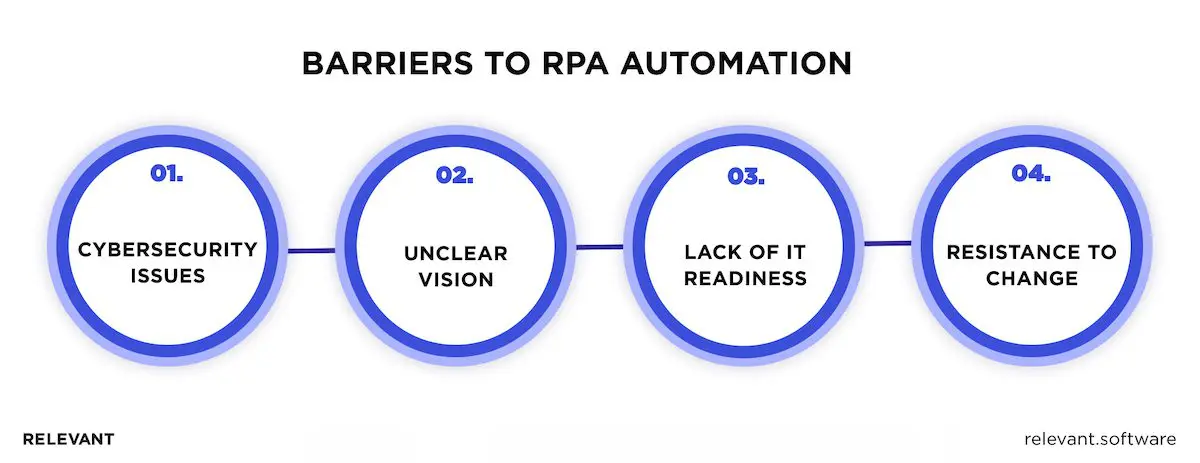10 Benefits of Robotic Process Automation You Should Know

In the current business world, maintaining competitiveness involves working smarter, not just harder. Robotic process automation (RPA) stands out as one of the most effective methods for achieving this. However, some entrepreneurs are still doubtful about the benefits of robotic process automation, mistakenly thinking that “RPA will take over human jobs.” Spoiler alert: RPA isn’t here to replace humans but rather to give them a much-needed coffee break while it handles the mundane stuff. One way or another, you’ll wonder how you ever managed without RPA services.
So, what are the benefits of using RPA that you might have missed? We’ll delve into them comprehensively. Whether you’re a seasoned tech professional or just starting with automation, these benefits of RPA will lead you to success (and maybe even a little extra free time).
What is Robotic Process Automation Exactly?
Robotic process automation leverages software bots to perform repetitive tasks that humans usually handle, such as entering data, processing transactions, and managing routine customer service. These bots function at the user interface level, replicating human interactions with software, which makes the technology highly adaptable and simple to deploy without needing to overhaul existing IT systems. This plug-and-play nature of RPA allows businesses to see quick returns on investment as bots start delivering efficiencies from day one.
Nevertheless, automation software isn’t something that just any employee can casually deploy—unless you trust Bob from accounting to program your robots, which we don’t recommend. Successful projects are built on thorough business analysis, professional deployment and configuration, and continual system improvements.
Key Components of RPA Systems
A robust system comprises several essential components, each contributing to RPA benefits for business:
- Recorder. The recorder is essential in RPA, allowing business users to capture and replicate the actions performed on a computer screen. It tracks every mouse click, keystroke, and data entry task performed by the user, creating a script that the bots will follow.
- Development Studio. This tool provides an intuitive environment for creating and developing RPA workflows. Users can define parameters, set conditions, and arrange task sequences using easy drag-and-drop functionality. Advanced users can also write custom scripts to handle more complex robotization tasks.
- Plugin/Extension. Plugins or extensions extend the functionality of RPA tools, enabling integration with various software applications and platforms. For example, an email plugin could allow a bot to read, send, and manage emails, while a database extension might enable direct interaction with SQL databases.
- Bot Runner. The bot runner is the engine that executes the automated tasks created in the development studio. Once a workflow is designed and tested, the bot runner deploys and manages the bots, ensuring they perform the tasks as intended.
- Control Center. In the Control Center, users find a centralized interface to schedule tasks, track bot performance, and handle configurations. It offers real-time oversight of bot performance, task completion, and workflow analysis.

Source: Javatpoint
A quick snapshot of how technology works:
- Task Identification: Businesses identify tasks that are repetitive, take a lot of time, and are prone to mistakes.
- Bot Development: Using an RPA platform, developers create bots tailored to specific tasks, programmed with predefined rules and workflows.
- Deployment: Bots are deployed to perform business operations autonomously, either in attended mode (with human oversight) or unattended mode (completely autonomous).
- Monitoring and Optimization: Business users track bot performance in a centralized control room and make adjustments as needed to boost efficiency and effectiveness, ensuring they maximize the benefits of robotic process automation.
Key RPA Adoption Trends
Let’s explore some key trends shaping the adoption of RPA today.
1. Adoption grows annually
The adoption of robotic process automation is on a consistent upward trend, with various use cases being implemented in different industries. By 2023, nearly 31% of companies had incorporated some form of this software technology into their operations. Avasant’s 2023 report on “Robotic Process Automation Adoption Trends and Customer Experience” reveals that inflation and the higher cost of labor are the main reasons behind the growing adoption of RPA.
2. Technology is rarely adopted in isolation
Robotic process automation is often implemented alongside other advanced technologies. As reported in UiPath’s 2023 “State of AI-Powered Automation,” companies frequently integrate RPA with artificial intelligence (AI) and machine learning (ML). This combination of technologies is typically deployed as a comprehensive suite to enhance overall robotization capabilities.
3. Broad implementation
Many companies are rolling out RPA on a wide scale within their organizations. Data shows that 50% of companies apply intelligent process automation across several business units, while 31% expand these efforts enterprise-wide. This broad deployment highlights the growing confidence in and reliance on RPA benefits for streamlined operations and higher productivity.

4. What industries can benefit the most from adopting robotic process automation?
In fields where repetitive tasks are common—such as manufacturing, finance, healthcare, and customer service—robotic process automation makes a huge difference. It enhances efficiency, minimizes errors, lowers expenses, and lets employees concentrate on more strategic and creative pursuits.
Top 10 Benefits of Robotic Process Automation
We’ve identified the top ten benefits of robotic process automation to demonstrate their impactful capabilities.

Streamlined Business Processes
Manual processes are typically sluggish, error-ridden, and inconsistent, whereas automation brings speed, accuracy, and reliability. For example, software robots can quickly and accurately manage data entry, invoice processing, and order fulfillment. But the benefits of RPA go beyond just operational efficiency. Also, RPA systems provide real-time data tracking and analysis that help pinpoint inefficiencies and areas for improvement. This continuous feedback loop ensures that processes are consistently refined and optimized.
Consider the case of DHL – a global logistics company that has seen RPA benefits in managing its shipment tracking and customer updates. This led to a dramatic drop in manual workload and a significant enhancement in process efficiency.
Error Reduction
Manual processes are often plagued by human errors, leading to costly mistakes and operational inefficiencies. One of the significant benefits of robotic process automation is its ability to mitigate these errors by following predefined rules and protocols without deviation. Tasks such as data entry, invoice processing, and compliance reporting, which are prone to human error, are now performed flawlessly by RPA systems, reducing the need for manual tasks and saving businesses time and money.
Blue Cross Blue Shield of Michigan, a leading health insurer, implemented RPA to automate its claims processing. Previously, manual data entry and verification were time-consuming and error-prone. By deploying software bots, the insurer significantly reduced processing time and error rates, leading to improved accuracy and customer satisfaction.
Reduced Operational Costs
Another compelling benefit of robotic process automation is its ability to reduce operational costs. By automating tasks traditionally handled by humans, businesses can significantly cut labor expenses and minimize resource usage. An in-depth analysis reveals that the upfront costs of implementing RPA are quickly offset by long-term savings.
Deloitte estimates that, on average, bots could replace about 20% of full-time employee capacity. However, those who have seen an RPA benefit in action are even more optimistic, suggesting that the capacity could be as high as 52%.
HSBC, an international banking and financial services giant, employed RPA to optimize its account opening process. The bank significantly reduced costs by automating tasks like data entry, document verification, and system updates. Software bots manage high volumes of applications efficiently, enabling the human workforce to focus on more complex, value-added activities.
Impact on Workforce and Labor Costs
The introduction of robotic process automation allows employees to shift from routine administrative tasks to more strategic and creative work. This shift not only enhances productivity but also fosters employee satisfaction. Businesses can also re-skill and up-skill their staff to effectively manage and optimize RPA systems, building a more dynamic and proficient team within their human resources.
Deutsche Bank, a leading global financial services provider, gets the benefit of RPA in various back-office process automation. This allowed the bank to redeploy employees from mundane tasks to more complex roles, such as client relationship management and risk analysis. The shift in focus not only improved employee job satisfaction but also enhanced the bank’s overall performance.
Enhanced Employee Productivity
A major boost in productivity is next of the key benefits of robotic process automation businesses seek. In fact, 78% of participants in the 2023 survey by Automation Anywhere cited productivity gains as a primary goal of RPA adoption.
For instance, Hiscox, an insurance firm, achieved a 300% reduction in request processing time for UK broker services with AI-powered bots. Another digital workforce project at Hiscox automated customer email processing, saving nearly 480 hours of work within the first two months.
Scalability and Flexibility
With the benefits of RPA, businesses gain exceptional scalability and flexibility, allowing them to tailor their operations based on demand. During peak periods, additional bots can be deployed to manage increased workloads without the need for extensive training.
Amazon, the e-commerce giant, heavily relies on RPA automation benefits to manage its complex and dynamic operations. In peak shopping seasons like Black Friday and Cyber Monday, the company deploys more software bots to cope with the surge in orders, customer questions, and inventory management tasks. With the benefits of robotic process automation, Amazon can scale their operations effortlessly during peak times without additional hiring.
Faster Response Times
Robotic process automation significantly improves response times in customer service and support, providing prompt and accurate service. The benefits of RPA automation like integration with existing CRM systems and other customer-facing platforms means that automated responses can be triggered instantly based on predefined rules and conditions.
For instance, robotic process automation solutions can automatically sort and prioritize incoming customer emails, route them to the appropriate department, and even generate initial responses. Additional RPA benefits include round-the-clock operation, providing 24/7 customer service without requiring extra staff.
Vodafone, a leading telecom company, adopted RPA to streamline its customer service processes. By automating routine tasks such as account inquiries, billing issues, and service requests, Vodafone achieved a 50% reduction in average response times.
Personalization and Customer Engagement
RPA enables businesses to deliver personalized experiences by automating customer interactions based on individual preferences and behaviors. For example, a marketing department can use the benefits of RPA to send personalized emails and offers, increasing customer engagement and conversion rates. Robotization also offers real-time analysis of customer data, helping businesses target their audience more accurately and respond promptly, which improves customer satisfaction.
Nationwide Insurance, a leading provider of insurance and financial services, implemented digital systems to streamline its customer service operations. With the automation of tasks such as policy inquiries, claims processing, and billing issues, the company was able to cut average response times by 50%. These benefits of robotic process automation led to increased customer satisfaction and loyalty.
Better Regulatory Compliance
The superior accuracy of bots compared to human employees greatly improves the handling of audits and regulatory compliance, particularly in data management and adherence to fiscal laws. This is one of the key benefits of robotic process automation, especially crucial for the insurance, financial services, and banking sectors. Automating these essential tasks helps businesses steer clear of costly fines and earn the trust of regulators and clients, confident that their operations are precise and dependable.
JPMorgan Chase, a leading global financial services firm, implemented automation technology to enhance its regulatory compliance processes. Through the automation of data validation, report generation, and audit preparation, the bank was able to improve regulatory compliance and reduce errors.
Risk Reduction
Cybersecurity experts agree that humans are often the weakest link in the security of business systems. Research from cybersecurity firm Tessian and Stanford University professor Jeff Hancock reveals that human error accounts for about 88% of cybercrime incidents.
With the benefits of RPA, cybersecurity is strengthened through the automation of network monitoring, application security, and disaster recovery. Less human involvement in these processes means fewer security breaches. Automated technology also guarantees GDPR compliance and data security, handling data entry, retrieval, and processing with a strong focus on privacy for European clients.
Allianz, a global leader in insurance and financial services, implemented this technology to bolster its cybersecurity defenses. Through robotization of vulnerability scanning, log analysis, and incident response, Allianz managed to drastically reduce human errors and greatly improve its capability to detect and handle cyber threats.
The benefits of RPA automation for risk reduction are clear: businesses can operate more confidently and securely, knowing that their processes are reliable and compliant.
Ideal Candidates for Automation
To maximize the benefits of RPA, it’s important to identify the right tasks for automation. These tasks typically include:
| Category | Description | Examples |
| Error-Prone | Tasks with a high likelihood of human error. | Data entry, manual calculations, compliance reporting. |
| Time-Consuming | Activities that require significant time to complete. | Order processing, transaction monitoring, and customer service responses. |
| Time-Critical | Processes that must be completed within strict deadlines. | Invoice processing, employee onboarding, and data consolidation. |
| High-Volume | Tasks that occur frequently and in large quantities. | Order processing, transaction monitoring, customer service responses. |
| Repetitive | Activities that involve repetitive actions | Copy-pasting data, generating standard reports, repetitive form filling. |
| Cross-Application | Processes requiring interaction with multiple software applications. | Syncing data between CRM and ERP systems, updating records across platforms. |
| Legacy Systems | Tasks within older systems that lack modern automation capabilities. | Maintaining records in outdated databases, interfacing with old software. |
| Cyclical | Activities that are performed repeatedly according to a set schedule. | Monthly inventory checks, weekly sales reports, quarterly audits. |
| Structured Data | Processes that involve well-organized data. | Generating invoices from structured datasets, processing survey results. |
Overcoming Barriers to RPA Automation
Organizations aiming to exploit robotic process automation benefits often encounter significant obstacles that can hinder process transformation. Companies can follow these effective steps to tackle these challenges and enjoy the benefits of RPA:

Barrier: Cybersecurity Issues
RPA bots process and transfer significant amounts of sensitive data between systems, which can jeopardize data security.
Best practices from Relevant experts:
- Equip RPA software with data encryption mechanisms.
- Monitor each bot’s activity to detect vulnerabilities and anomalies in behavior.
Barrier: Unclear Vision
Securing stakeholder buy-in can be challenging, as RPA technology adoption often requires significant resources and investments.
Best practices from Relevant experts:
- Convince stakeholders by clearly showing the measurable benefits of robotic process automation.
- Collaborate with the C-suite to develop a clear vision and strategy and build a detailed automation roadmap.
Barrier: Lack of IT Readiness
A lack of IT readiness to adopt technology reduces the chances for successful and cost-effective digital transformation with RPA implementation.
Best practices from Relevant experts:
- Instruct the IT team to review the company’s entire tech stack, from enterprise software to customer-facing systems, to determine its capability to support RPA deployment.
- Design a proof of concept for RPA to evaluate whether the technology fits and if your organization can benefit from RPA automation.
Barrier: Resistance to Change
If employees fail to see and admit the benefits of RPA automation, the adoption process for this technology may be slowed.
Best practices from Relevant experts:
- Communicate the changes clearly and arrange training for all affected employees.
- Organize a user support team to manage issues effectively and support employees as they adapt to the new technology.
Implement RPA with Relevant
The majority of organizations that have adopted process automation consider RPA a cornerstone of their strategy. Its proven success across various sectors highlights the need for ongoing scaling, development, and transformative efforts. After all, if it’s good enough for the finance and healthcare industries, it’s probably time to get on board.
If you wish to get the benefits of RPA for your business, partnering with a professional RPA and intelligent automation provider is what you need. We at Relevant are fully prepared to design and implement an RPA solution that aligns with your specific business needs and objectives. Get in touch to leverage robotic process automation benefits!



